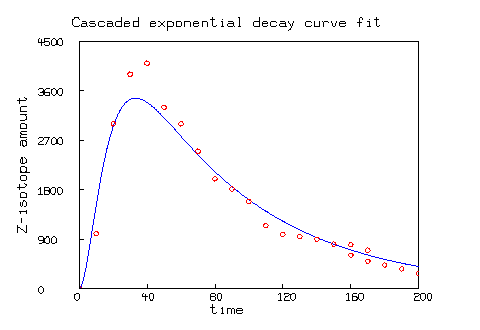
![[Previous Document]](http:/Images/Left.gif)
![[Back to CSI Home Page]](http:/Images/Home.gif)
![[Next Document]](http:/Images/Right.gif)
Denote the amounts of the three isotopes by X, Y, and Z, respectively. Denote the initial amounts of the isotopes by X0, Y0, and Z0; and denote the corresponding rates of decay by K, L, and M, which are positive numbers. The differential equations of the radioactive decay process described above are:
We suppose that only the decay of isotope Z produces radiation which can be detected, and that measurements of radiation from decays of isotope Z (which is proportional to the amount of Z) are made at a series of times Ti, i = 1,2,...,200. These measurements are read into a 200 row, two column matrix called DATA, column 1 of which contains the times, and column 2 of which contains the measured values. We suppose that the initial conditions are known, e.g. X0 = 5000, Y0 = 0, and Z0 = 0. Initial guesses are required for K, L, and M, from which the process of estimating K,L, and M will proceed. We take these guesses to be K=1, L=1, and M=1.
In MLAB, this problem may be formulated as follows:
* FCT X'T (T) = -K*X
* FCT Y'T (T) = K*X-L*Y
* FCT Z'T (T) = L*Y-M*Z
* INIT X(0) = 5000
* INIT Y(0) = 0
* INIT Z(0) = 0
* K = 1; L = .1; M = .01;
* CONSTRAINTS Q = {K > 0, L > 0, M > 0}
* DATA = READ(DECAY,200,2)
Now we may estimate K, L, and M using the following MLAB FIT statement.
* FIT (K,L,M),Z TO DATA, CONSTRAINTS Q
The output of the fit statement is the table shown below, containing the least squares estimates, along with standard deviations which help the user to determine the quality of the fit.
final parameter values value error dependency parameter 0.1133576575 0.9382481192 0.9996464477 K 0.1171530638 0.8648505987 0.9996463229 L 0.01384391436 0.0005651783173 0.07687919473 M 17 iterations CONVERGED best weighted sum of squares = 1.315000e+06 weighted root mean square error = 2.564176e+02 weighted deviation fraction = 9.784715e-02 R squared = 9.595270e-01 no active constraints
A graph of the data and the fitted curve is a useful measure of the quality of the fit. This is easily done in MLAB.
* DRAW DATA LINETYPE NONE, PT CIRCLE, PTSIZE 0.01, COLOR RED * DRAW POINTS(Z,0:200!160) COLOR BLUE * IMAGE COLOR GREY * BOTTOM TITLE "time" * LEFT TITLE "Z-isotope amount" * TOP TITLE "Cascaded exponential decay curve fit" * VIEW
MLAB is unique in its power and ease of use in handling differential equations in curve-fitting. Delays, implicitly-defined functions, and recursively-defined functions may all be used. The MLAB differential equation solver uses Adams' fourth order predictor-corrector method for speed and Gear's implicit predictor-corrector method for stiff equations. The derivatives needed for the elements of the Jacobian in Gear's method are computed symbolically and evaluated from the resulting formulas. Integration step size is chosen automatically and varied so as to maximize speed while maintaining specified accuracy.
![[Previous Document]](http:/Images/Left.gif)
![[Back to CSI Home Page]](http:/Images/Home.gif)
![[Next Document]](http:/Images/Right.gif)